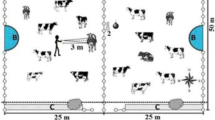Abstract
The general principles of the mechanisms of heat transfer are well known, but knowledge of the transition between evaporative and non-evaporative heat loss by Holstein cows in field conditions must be improved, especially for low-latitude environments. With this aim 15 Holstein cows managed in open pasture were observed in a tropical region. The latent heat loss from the body surface of the animals was measured by means of a ventilated capsule, while convective heat transfer was estimated by the theory of convection from a horizontal cylinder and by the long-wave radiation exchange based on the Stefan–Boltzmann law. When the air temperature was between 10 and 36°C the sensible heat transfer varied from 160 to –30 W m−2, while the latent heat loss by cutaneous evaporation increased from 30 to 350 W m−2. Heat loss by cutaneous evaporation accounted for 20–30% of the total heat loss when air temperatures ranged from 10 to 20°C. At air temperatures >30°C cutaneous evaporation becomes the main avenue of heat loss, accounting for approximately 85% of the total heat loss, while the rest is lost by respiratory evaporation.






Similar content being viewed by others
References
Amakiri SF, Funsho ON (1979) Studies of rectal temperature, respiratory rates and heat tolerance in cattle in the humid tropics. Anim Prod 28:329–335
Cena K, Monteith JL (1975) Transfer processes in animal coats. III. Water vapour diffusion. Proc R Soc Lond B 188:413–423
Chapman AJ (1987) Fundamentals of heat transfer. McMillan, New York
daSilva RG (2000a) Um modelo para a determinação do equilibrio térmico de bovinos em ambientes tropicais. Rev Bras Zootec 29(4):1244–1252
daSilva RG (2000b) Introdução à bioclimatologia animal. Nobel, São Paulo
daSilva RG, LaScala N Jr, Tonhati H (2003) Radiative properties of the body surface of cattle and other animals. Trans ASAE 46(3):913–918
Drapper NR, Smith H (1998) Applied regression analysis, 3rd edn. Wiley, New York
Finch VA (1985) Comparison of non-evaporative heat transfer in different cattle breeds. Aust J Agric Res 36:497–508
Finch VA, Bennett IL, Holmes CR (1982) Sweating response in cattle and its relation to rectal temperature, tolerance of sun and metabolic rate. J Agric Sci 99:479–487
Freund RJ, Littell RC (2000) SAS system for regression, 3rd edn. SAS Institute, Cary, N.C.
Gebremedhin KG, Cramer CO, Porter WP (1981) Predictions and measurements of heat production and food and water requirements of Holstein calves in different environments. Trans ASAE 3:715–720
Gebremedhin KG, Wu B (2001) A model of evaporation cooling of wet skin surface and fur layer. J Thermal Biol 26:537–545
Herrington LP, Winslow CEA, Gagge AP (1937) The relative influence of radiation and convection upon vasomotor temperature regulation. Am J Physiol 120:133–143
Harvey WR (1960) Least-squares analysis of data with unequal subclass numbers. USDA publication no. 20-8. USDA, Beltaville
Hillman PE, Lee CN, Parkhurst A (2001) Impact of hair color on thermoregulation of dairy cows to direct sunlight. In: The Annual International Meeting of the ASAE, Sacramento. Paper no. 014301
Kibler HH, Brody S (1954) Influence of wind on heat exchange and body temperature regulation in Jersey, Holstein, Brown Swiss and Brahman cattle. Mo Agric Exp Stn Res Bull 552:39
Littell RC, Freund RJ, Spector PC (1991) SAS System for linear models. 3rd edn. SAS Institute, Cary, N.C.
Maia ASC, da Silva RG, Bertipaglia ECA (2003) Características do pelame de vacas Holandesas em um ambiente tropical: Um estudo genético e adaptativo. Rev Braz Zootec 32(4):843–853
Maia ASC, da Silva RG, Battiston CM (in press a) Respiratory heat loss of Holstein cows in a tropical environment. Int J Biometeorol
Maia ASC, daSilva RG, Bertipaglia ECA (2005) Environmental and genetic variation of the effective radiative properties of the coat of Holstein cows under tropical conditions. Livestock Prod Sci 92/3:307-315
McArthur AJ (1987) Thermal interaction between animal and microclimate: a comprehensive model. J Theor Biol 126:203–238
McLean JA (1963a) The partition of insensible losses of body weight and heat from cattle under various climatic conditions. J Physiol, 427–447
McLean JA (1963b) Measurement of cutaneous moisture vaporization from cattle by ventilated capsules. J Physiol 417–426
McLean JA, Calvert DJ (1972) Influence of air humidity on the partition of heat exchanges of cattle. J Agric Sci 78:303–307
Montheith JL, Unsworth MH (1990) Principles of environmental physics, 2nd edn. Arnold, London
Pocay PLB, Pocay VG, Starling JMC, Silva RG (2001) Respostas fisiológicas de vacas Holandesas predominantemente brancas e predominantemente negras sob radiação solar direta. Ars Vet 17(2):155–161
SAS Institute (1995) User’s guide: statistics, version 6, 10th edn. SAS Institute, Cary, N.C.
Scheleger AV, Turner HG (1965) Sweating rates of cattle in the field and their reaction to diurnal and seasonal changes. Aust J Agric Res 16:92–106
Stevens DG (1981) A model of respiratory vapor loss in Holstein dairy cattle. Trans ASAE 24:151–158
Thompson RD (1998) Atmospheric processes and systems. Routledge, London
Turnpenny JR, McArthur AJ, Clark JA, Wathes CM (2000) Thermal balance of livestock. 1. A parsimonious model. Agric For Meteorol 101:15–27
Udo HM (1978) Hair coat characteristics in Friesian heifers in the Netherlands and Kenya. Landbouwhogeschool Wageningen, Veenman, Wageningen
Author information
Authors and Affiliations
Corresponding author
Additional information
Part of first author’s doctoral thesis
Rights and permissions
About this article
Cite this article
Maia, A.S.C., daSilva, R.G. & Battiston Loureiro, C.M. Sensible and latent heat loss from the body surface of Holstein cows in a tropical environment. Int J Biometeorol 50, 17–22 (2005). https://doi.org/10.1007/s00484-005-0267-1
Received:
Revised:
Accepted:
Published:
Issue Date:
DOI: https://doi.org/10.1007/s00484-005-0267-1




